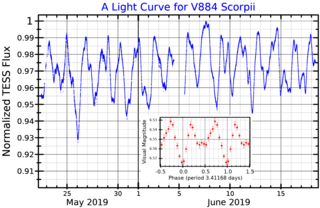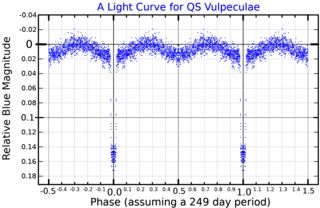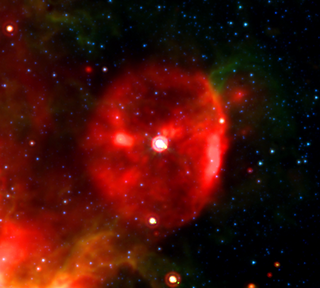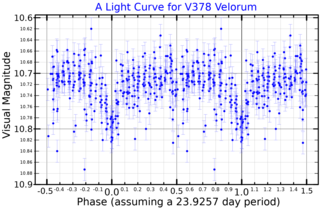
UW Canis Majoris is a star in the constellation Canis Major. It is classified as a Beta Lyrae eclipsing contact binary and given the variable star designation UW Canis Majoris. Its brightness varies from magnitude +4.84 to +5.33 with a period of 4.39 days. Bode had initially labelled it as Tau2 Canis Majoris, but this designation had been dropped by Gould and subsequent authors.

HR 2554, also known as V415 Carinae and A Carinae, is an eclipsing spectroscopic binary of the Algol type in the constellation of Carina whose apparent visual magnitude varies by 0.06 magnitude and is approximately 4.39 at maximum brightness. Its primary is a G-type bright giant star and its secondary is an A-type main-sequence star. It is approximately 553 light-years from Earth.

AO Cassiopeiae, also known as Pearce's Star, is a binary system composed of an O8 main sequence star and an O9.2 bright giant that respectively weigh anywhere between 20.30 and 57.75 times and 14.8 and 31.73 times the mass of the Sun.

32 Cygni is the Flamsteed designation for a binary star system in the Cygnus constellation. It is a 4th magnitude star, which can be seen with the naked eye under suitably dark skies. Parallax measurements give an estimated distance of 1,100 light-years (320 parsecs) from the Earth. However, Schröder et al. (2007) suggest the actual value, after correcting for Malmquist bias, may be closer to 1,174 light-years (360 parsecs). Although it is a spectrsocopic binary with components that cannot be separated visually, it has two entries in the Henry Draper Catalogue, with identical magnitudes and positions, but showing the spectral types of the two components.

V636 Scorpii is a multiple star system in the constellation Scorpius, 3,000 light years away. The primary is a Classical Cepheid variable and its visual magnitude varies from 6.4 to 6.9.

4U 1700-37 is one of the stronger binary X-ray sources in the sky, and is classified as a high-mass X-ray binary. It was discovered by the Uhuru satellite. The "4U" designation refers to the fourth Uhuru catalog.

HR Carinae is a luminous blue variable star located in the constellation Carina. It is surrounded by a vast nebula of ejected nuclear-processed material because this star has a multiple shell expanding atmosphere. This star is among the most luminous stars in the Milky Way. It has very broad emission wings on the Balmer lines, reminiscent from the broad lines observed in the spectra of O and Wolf–Rayet stars. A distance of 5 kpc and a bolometric magnitude of -9.4 put HR Car among the most luminous stars of the galaxy.

YZ Cassiopeiae is a star system 103.8 parsecs (339 ly) away from Earth, in the constellation Cassiopeia. It comprises three stars: an eclipsing Algol-type binary and a visually fainter star about 3000 AU distant.

22 Vulpeculae is a binary star system in the northern constellation Vulpecula. Based on its parallax, it is located some 1,490 light-years away, and it has an apparent magnitude of about 5.2, making it visible to the naked eye. The system is moving closer to the Earth with a heliocentric radial velocity of −23 km/s.

HD 168625 is a blue hypergiant star and candidate luminous blue variable located in the constellation of Sagittarius easy to see with amateur telescopes. It forms a visual pair with the also blue hypergiant HD 168607 and is located to the south-east of M17, the Omega Nebula.

Gamma Phoenicis is a star system in the constellation Phoenix, located around 71.63 parsecs (233.6 ly) distant.

KQ Puppis is a spectroscopic binary variable star in the constellation Puppis. A red supergiant star and a hot main sequence star orbit each other every 9,742 days. Its apparent magnitude varies between 4.82 and 5.17.

Theta Muscae is a multiple star system in the southern constellation Musca, containing a Wolf-Rayet star and two massive companions. With an apparent magnitude of 5.5, it is the second-brightest Wolf–Rayet star in the sky, although much of the visual brightness comes from the massive companions and it is not one of the closest of its type.

S Muscae is a classical (δ) Cepheid variable star in the constellation Musca about 2,600 light years away.

V3903 Sagittarii is an eclipsing binary star system in the constellation Sagittiarus. It creates an H II region LBN 29 1,070 parsecs away from the Sun.

WR 20a is an eclipsing binary star belonging to or recently ejected from the young, massive cluster Westerlund 2. It was discovered in 2004 to be one of the most massive binary systems known, for which the masses of the components have been accurately measured.

CD Crucis, also known as HD 311884, is an eclipsing binary star system in the constellation Crux. It is around 14,000 light years away near the faint open cluster Hogg 15. The binary contains a Wolf–Rayet star and is also known as WR 47.

HDE 316285 is a blue supergiant star in the constellation Sagittarius. It is a candidate luminous blue variable and lies about 6,000 light years away in the direction of the galactic centre.

WR 12 is a spectroscopic binary in the constellation Vela. It is an eclipsing binary consisting of a Wolf-Rayet star and a luminous companion of unknown spectral type. The primary is one of the most luminous stars known.

WR 9 is a spectroscopic binary in the constellation Puppis consisting of a Wolf-Rayet star and a class O star. It is around 12,000 light years away.


















